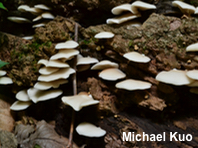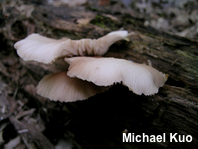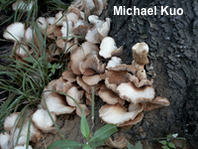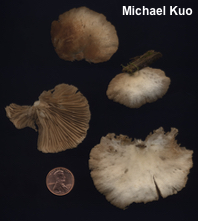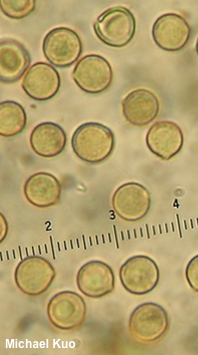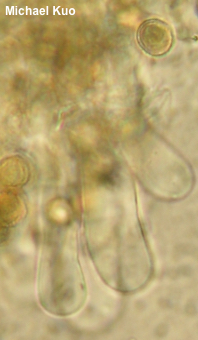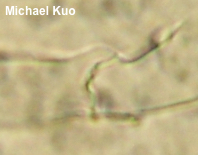| Major Groups > Gilled Mushrooms > Dark-Spored > Pleurotoid Mushrooms > Crepidotus > Crepidotus applanatus |

|
[ Basidiomycota > Agaricales > Inocybaceae > Crepidotus . . . ] Crepidotus applanatus by Michael Kuo, 4 August 2023 Species of Crepidotus are not the easiest of mushrooms to identify without microscopic analysis, but a few features may help separate Crepidotus applanatus. It is fairly large (for a Crepidotus), with a cap usually wider than 4 cm; the cap surface is relatively bald, except for some fuzz near the point of attachment; and it is found on the deadwood of hardwoods. However, these non-microscopic features can apply to other species, so you will want to use your microscope if you want more confidence in your identification. Look for the presence of clamp connections, slightly swollen cheilocystidia, and round, finely punctate spores measuring 4.5–6 µm. The spore measurements are virtually the only feature separating the Baby Bear-spored Crepidotus applanatus from Crepidotus malachius, which has larger, Papa Bear spores. Europe's Crepidotus pini has Mama Bear spores, between the size ranges for applanatus and malachius, but can be separated by its habitat on the deadwood of Scots pine rather than hardwoods. These species concepts for Crepidotus applanatus, malachius, and pini are fairly recent (Jančovičová et al. 2022) and, therefore, may not match the concepts in your field guide. Description: Ecology: Saprobic; growing gregariously or (more commonly) in overlapping clusters on dead hardwood stumps and logs; summer and fall; originally described from Europe (Persoon 1796) and neotypified from Scotland (Senn-Irlet 1995); widespread in Eurasia; widely distributed in North America east of the Great Plains, and present in the Pacific Northwest. The illustrated and described collections are from Illinois. Cap: 2–6 cm; irregularly semicircular to fan-shaped; bald or finely fibrillose to whitish-fuzzy near the point of attachment; hygrophanous; pale brown, becoming nearly whitish; the margin becoming wavy and often lined with maturity. Gills: Close; short-gills frequent; whitish, becoming pale brown with maturity. Stem: Absent. Flesh: Soft; thin; whitish to brownish; unchanging when sliced. Odor and Taste: Not distinctive. Chemical Reactions: KOH on cap surface negative. Spore Print: Brown. Microscopic Features: Spores 4.5–6 µm; globose to subglobose; finely stippled or virtually smooth; yellowish to brownish in KOH; inamyloid. Basidia 18–22 x 4–6 µm; subclavate; 4-sterigmate. Pleurocystidia not found. Cheilocystidia 35–45 x 6–10 µm; cylindric to clavate, subclavate, or somewhat irregular; smooth; thin-walled; hyaline in KOH. Pileipellis a cutis; elements 5–12.5 µm wide, smooth, hyaline in KOH. Clamp connections present. REFERENCES: (C. H. Persoon, 1796) P. Kummer, 1871. (Kauffman, 1918; Hesler & Smith, 1965; Phillips, 1981; Phillips, 1991/2005; Schalkwijk-Barendsen, 1991; Lincoff, 1992; Senn-Irlet, 1995; Barron, 1999; Breitenbach & Kränzlin, 2000; McNeil, 2006; Miller & Miller, 2006; Bandala et al., 2008; Buczacki et al., 2013; Kuo & Methven, 2014; Baroni, 2017; Senn-Irlet, 2018; Læssøe & Petersen, 2019; Jančovičová et al., 2022.) Herb. Kuo 08010203, 07300907, 06081303. This site contains no information about the edibility or toxicity of mushrooms. |
© MushroomExpert.Com |
|
Cite this page as: Kuo, M. (2023, August). Crepidotus applanatus. Retrieved from the MushroomExpert.Com Web site: http://www.mushroomexpert.com/crepidotus_applanatus.html |
